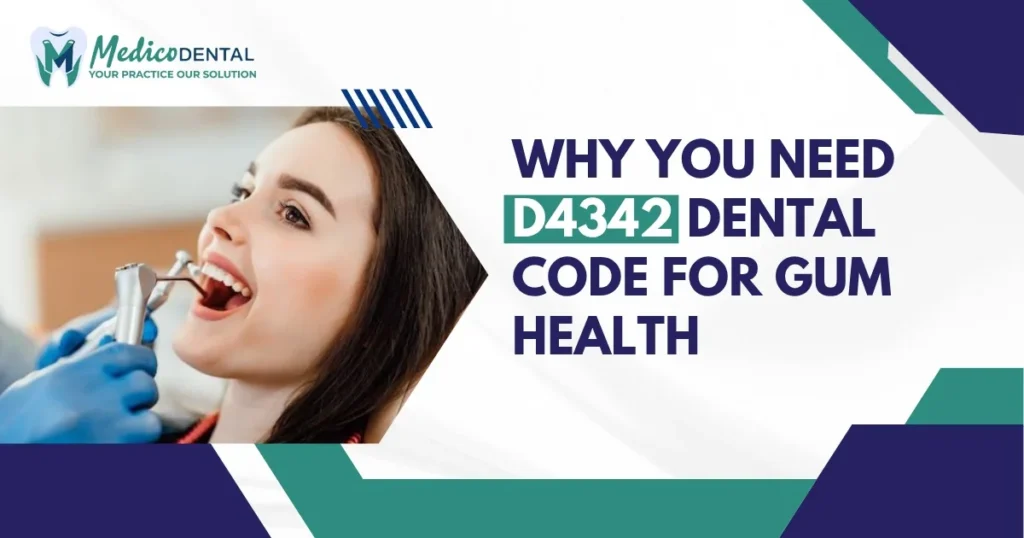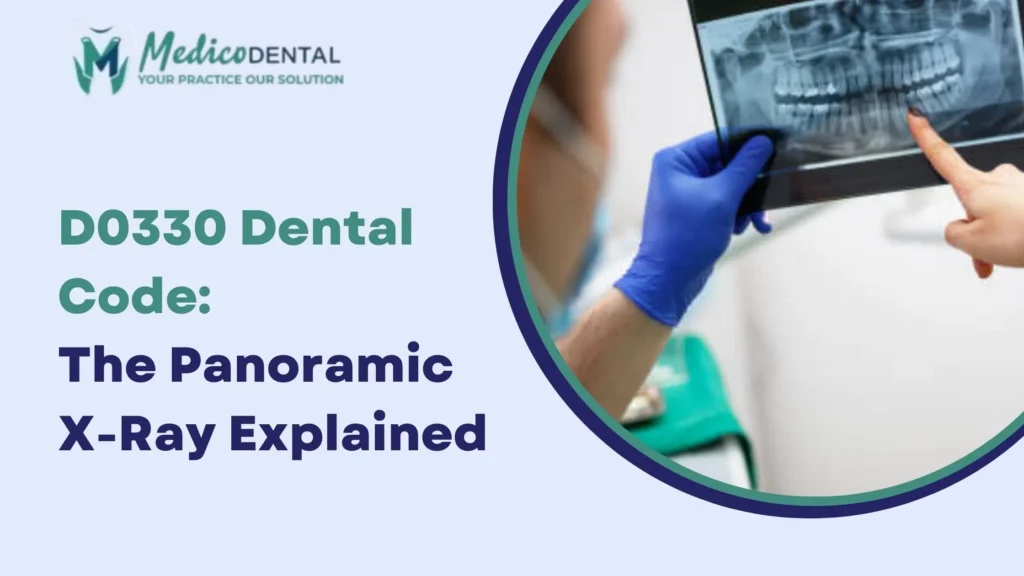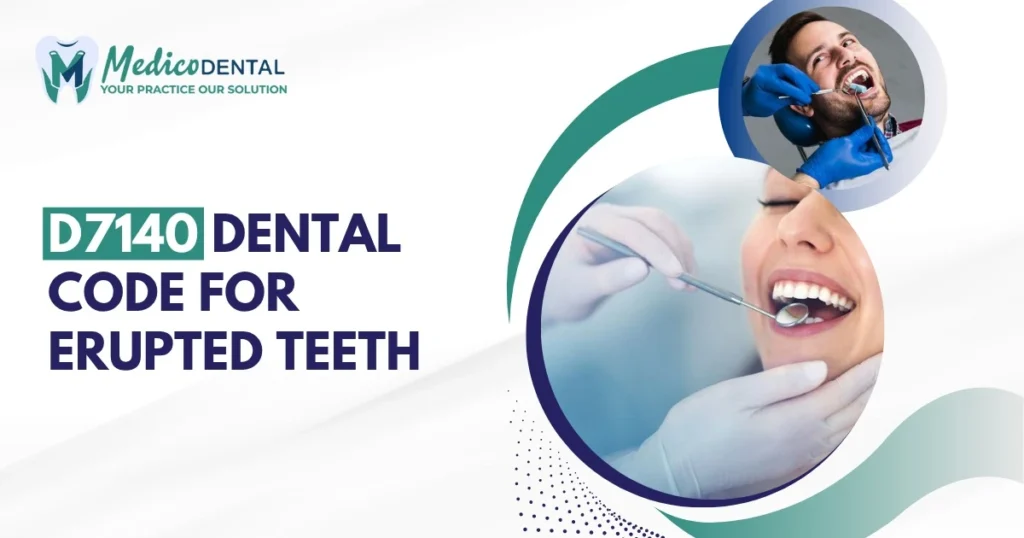D4342 is a procedure used in dentistry to address areas of gum disease by targeting specific teeth in one quadrant of the mouth. Through deep cleaning, it removes harmful plaque and tartar from the root surfaces of affected teeth. This non surgical treatment helps restore gum health and can prevent further damage from periodontal disease.
What is D4342 Dental Code?
D4342 is a dental procedure code for “Periodontal Scaling and Root Planing One to Three Teeth Per Quadrant.” It is a deep cleaning procedure used to treat areas of gum disease by removing plaque, tartar (calculus), and infected root surfaces from the teeth. This procedure is typically done when gum disease affects one to three teeth in a specific area or quadrant of the mouth. It’s a non surgical treatment aimed at halting the progression of periodontal disease.
Overview of Periodontal Scaling and Root Planing
Periodontal scaling and root planing (SRP) is a two step, deep cleaning procedure that targets both the visible part of the tooth and the tooth’s root, where plaque and tartar can accumulate. Scaling refers to the process of removing plaque and tartar from the surface of the teeth, while root planing smooths out the rough surfaces of the tooth roots to prevent future plaque buildup. By treating these areas, SRP helps control gum inflammation and infection, promoting healthier gums and teeth.
Understanding the D4342 Procedure
Description of the Procedure
The D4342 procedure involves cleaning one to three teeth per quadrant, which typically includes the upper or lower part of the mouth divided into four quadrants. The dentist or hygienist will clean beneath the gumline to remove tartar, plaque, and bacteria, which are the root causes of gum disease. This is done to reduce inflammation, promote healing, and prevent further progression of periodontal disease.
Tools and Techniques Used
Specialized tools are used during the D4342 procedure, such as ultrasonic scalers and hand instruments. The ultrasonic scaler uses high frequency vibrations to loosen and remove tartar and plaque, while the hand instruments help smooth the root surfaces. The goal is to make the root surfaces smooth so that the gums can reattach properly, reducing pocket depths between the teeth and gums.
Local Anesthesia in D4342
Before the procedure begins, the area to be treated is numbed with local anesthesia to ensure that the patient is comfortable throughout the process. Anesthesia helps minimize discomfort and allows the dentist or hygienist to work effectively without causing pain. Patients may experience some tenderness after the anesthesia wears off, but it is usually manageable with over the counter pain relievers.
Indications for D4342
When is D4342 Used?
D4342 is generally used for patients with localized periodontal disease where the infection or inflammation is affecting only a few teeth in a particular quadrant of the mouth. This procedure is recommended when routine cleaning (prophylaxis) is not enough to address gum disease, and more intensive cleaning is required to prevent tooth loss and further damage to the gums and bone.
Common Conditions Treated by D4342
- Localized Periodontal Disease: Gum infection or inflammation affecting one to three teeth in a specific quadrant.
- Gingivitis: Early stage gum disease where the gums become swollen and bleed.
- Deep Pockets: When the spaces between the teeth and gums become too deep for normal cleaning.
- Receding Gums: If gum tissue is beginning to pull away from the teeth, exposing the roots.
The Role of D4342 in Periodontal Disease Treatment
D4342 plays a crucial role in preventing the progression of periodontal disease by removing the source of infection. It can reverse early stages of gum disease and help restore healthy gum tissue. By scaling and root planing, it reduces bacterial load in the pockets of the gums, allowing the gums to heal and tighten around the teeth.
How D4342 Differs from Other Periodontal Codes
D4342 vs D4341: Key Differences
D4342 and D4341 are both periodontal scaling and root planing codes, but they differ based on the number of teeth treated.
- D4342 is used when one to three teeth in a quadrant are affected, making it a less extensive treatment compared to D4341.
- D4341 applies when four or more teeth in a quadrant need scaling and root planing. This procedure is more intensive and is generally used for more advanced stages of periodontal disease.
The choice between D4342 and D4341 depends on the severity of the gum disease and how many teeth need treatment.
D4342 vs D4343: What Sets Them Apart?
D4342 is used for localized periodontal scaling and root planing for one to three teeth per quadrant, whereas D4343 is used when four or more teeth in a quadrant require the same treatment. The difference lies in the number of teeth treated, with D4343 being a more comprehensive procedure for broader gum disease involvement.
The D4342 Procedure Step by Step
Preparing for the Procedure
Before starting the D4342 procedure, your dentist will review your medical and dental history to ensure that you are a suitable candidate for the treatment. The area to be treated is then numbed using local anesthesia. The dentist or hygienist will also explain the process and what to expect during the procedure.
The Scaling and Root Planing Process
The scaling and root planing process itself is done in one sitting, though it may take more than one visit depending on the severity of the disease and how many teeth are being treated.
- Scaling: The dentist will use ultrasonic instruments and hand scalers to remove plaque and tartar from the tooth surfaces above and below the gumline.
- Root Planing: The roots of the teeth are smoothed out to eliminate rough spots where bacteria can thrive. This step helps the gums heal and reattach to the teeth.
Aftercare and Recovery
After the procedure, it is normal to experience mild tenderness or discomfort for a few days. You may be advised to follow some aftercare instructions, including:
- Avoiding hard foods for a few days to prevent irritation.
- Brushing and flossing carefully to avoid damaging the treated areas.
- Rinsing with saltwater or antiseptic mouthwash to promote healing.
Regular follow up visits will be necessary to monitor your recovery and check the gum health. Your dentist may schedule a re evaluation to ensure that the infection has resolved.
Benefits of D4342 for Patients
Short Term and Long Term Advantages
In the short term, D4342 helps alleviate the immediate symptoms of gum disease, such as swelling, bleeding, and tenderness. By removing plaque and tartar buildup from beneath the gumline, patients often experience reduced inflammation and discomfort soon after the procedure. Long term, D4342 promotes healthier gums by allowing the gum tissue to reattach to the teeth, preventing further damage and tooth loss. By halting the progression of periodontal disease, it contributes to better overall oral health, improving the function and aesthetics of your smile.
Impact on Oral Health and Gum Disease Prevention
D4342 plays a key role in preventing the worsening of gum disease, which can otherwise lead to tooth mobility, gum recession, and even tooth loss. By addressing localized areas of infection early on, the procedure helps control the spread of bacteria and inflammation, significantly reducing the risk of more severe periodontal conditions. Patients who undergo D4342 are better able to maintain their oral health and avoid the need for more invasive treatments such as gum surgery or tooth extractions.
Billing and Insurance for D4342
How D4342 is Billed
D4342 is typically billed as a non surgical procedure and is often covered under dental insurance plans. The procedure is generally itemized per quadrant, meaning that the cost will depend on the number of teeth involved and the complexity of the treatment. It’s important to check with your dental office about the exact pricing, as the cost can vary based on factors such as the region, the dentist’s office, and the patient’s specific needs.
Insurance Coverage and Requirements
Most dental insurance plans do cover D4342, though the level of coverage can vary. Some plans may cover a percentage of the treatment cost, while others might require the patient to pay a portion out of pocket, depending on the terms of the plan. To ensure full coverage, make sure to confirm with your insurer beforehand that the procedure is included under your plan, and ask about any specific requirements for prior approval or documentation that might be needed.
Common Billing Mistakes to Avoid
- Incorrect Code Use: Ensure that the correct code is used D4342 is for one to three teeth per quadrant, while D4341 should be used for four or more teeth in a quadrant.
- Failing to Check Insurance Limits: Some insurance policies may limit the number of quadrants that can be treated within a given period. It’s essential to confirm whether your policy covers the full procedure.
- Incomplete Documentation: Make sure the dental billing office provides all necessary documentation to your insurance company, such as x rays and treatment notes, to avoid claim denials.
Potential Risks and Considerations of D4342
Possible Side Effects and Complications
While D4342 is generally a safe and effective procedure, there can be some side effects. After the treatment, patients may experience:
- Tenderness and discomfort in the treated areas, which can typically be managed with over the counter pain relievers.
- Slight gum bleeding during the first few days as the gums heal and reattach to the tooth surfaces.
- Swelling or sensitivity in the gums, which usually subsides after a few days.
Though rare, complications such as infection or excessive bleeding can occur, particularly if the patient doesn’t follow post treatment care instructions properly. It’s essential to follow your dentist’s aftercare advice to minimize risks and promote quicker recovery.
Contraindications for D4342 Treatment
D4342 may not be suitable for everyone, particularly those with:
- Severe systemic health conditions (e.g., uncontrolled diabetes or blood clotting disorders) that could complicate healing or increase the risk of infection.
- Pregnancy (especially during the first trimester) may require special consideration before undergoing periodontal treatments.
- Allergic reactions to local anesthetics or certain medications used during the procedure may prevent some patients from receiving treatment.
Always consult with your dentist about any existing health conditions or concerns before undergoing treatment.
Conclusion
D4342 is an essential procedure for treating localized gum disease and preventing its progression. It offers both short term relief from gum inflammation and long term protection against tooth loss by cleaning the roots and promoting gum reattachment. This non surgical procedure can drastically improve your gum health and overall oral hygiene, saving you from more extensive treatments down the road.
Periodontal health is crucial for maintaining a healthy mouth, and early intervention through treatments like D4342 can make a significant difference in preventing serious oral health problems. Seeking professional care ensures that you receive the right treatment tailored to your specific needs. Regular check ups with your dentist and early treatment of gum disease will help protect your smile for years to come.
FAQs
How long does the D4342 procedure take?
Ans. The procedure typically takes around one to two hours, depending on the number of teeth being treated and the severity of the gum disease. Some patients may need multiple visits if the disease is extensive.
Will I feel pain during the procedure?
Ans. Since the area is numbed with local anesthesia, you shouldn’t feel pain during the procedure. However, some discomfort may be felt once the anesthesia wears off.
How soon will I see results?
Ans. After the procedure, most patients begin to notice improvements in their gum health within a few days as the inflammation reduces. Full healing can take a few weeks, depending on the severity of the condition.



